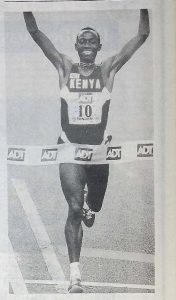
LONDON: World Marathon champion Douglas Wakiihuri enjoyed a traditional Japanese rice breakfast on April 23. A few hours later the 25 year old Kenyan calmly outclassed the best field ever assembled in Britain to win the ninth London marathon in a personal best 2:09:03.
Wakihuri’s most striking attribute was his composure, a legacy both of his studies in Buddhist philosophy and the training ‘methods he has adopted since moving 10 Japan six years ago. Born in Mombassa and brought up in Nairobi, Wakiihuri was heavily influenced as a teenager by Shunichi Kobayashi, a Japanese writer based in Kenya.
Kobayashi inspired the young Kenyan with his stories about Japanese marathon training based on a balance of physical and ‘mental commitment. Fired with the desire 10 become a world class marathon runner, Wakithuri wrote 10 Kiyoshi Nakamura coach of Japan’s most successful marathon runner Toshihiko Seko and in 1983 he went to Japan to live and train.
Nakamura died in 1985 but Wakithurt was by then committed to living in Japan. In the following year he ran his first marathon clocking 2:13:34 in his first attempt at the 42.195 kms distance.
In 1987 Wakithuria stranger o even his own teammates astonished the athletic world when he won the world championship ‘marathon in Rome. Last year he demonstrated that Rome had been no fluke when he {finished second to Italian Gelindo Bordin in the Seoul Olympics.
The London run was only Wakithuri’s {fifth marathon but the Kenyan ran with total control, making light work of challenges from Djibouti’s Ahmed Saleh and Australian Steve Moneghett.
“He always looks in complete control. That’s why he always beats me,” second place Moneghetti said.
Wakithuri however said he did not feel confident about winning until the last few kilometers, “Who was behind me was the ‘most troublesome thing in my mind. Tknew ai that siage the race would be very tough. It wasn’t the easiest marathon I have raced. but the weather conditions were ideal and 1 was always confident in the last few miles.”
Article extracted from this publication >> June 2, 1989